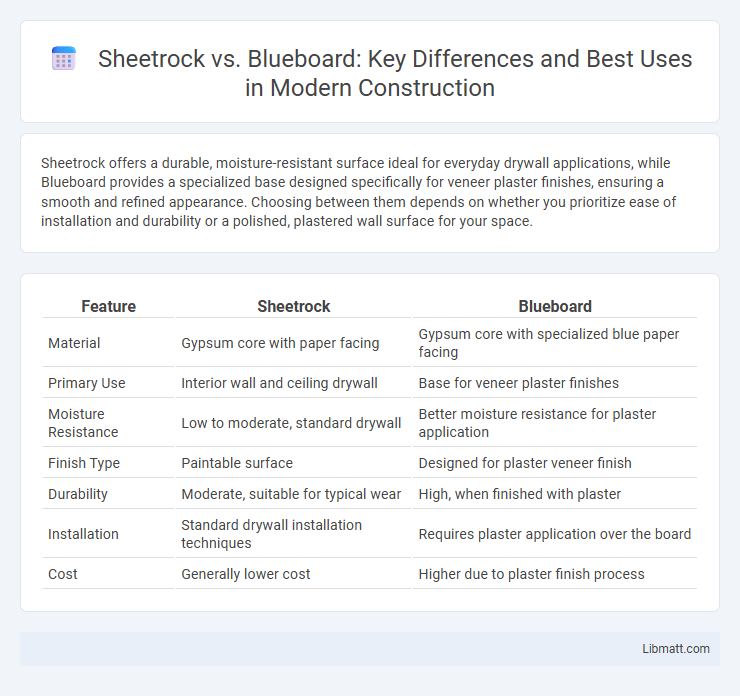Sheetrock offers a durable, moisture-resistant surface ideal for everyday drywall applications, while Blueboard provides a specialized base designed specifically for veneer plaster finishes, ensuring a smooth and refined appearance. Choosing between them depends on whether you prioritize ease of installation and durability or a polished, plastered wall surface for your space.
Table of Comparison
| Feature | Sheetrock | Blueboard |
|---|---|---|
| Material | Gypsum core with paper facing | Gypsum core with specialized blue paper facing |
| Primary Use | Interior wall and ceiling drywall | Base for veneer plaster finishes |
| Moisture Resistance | Low to moderate, standard drywall | Better moisture resistance for plaster application |
| Finish Type | Paintable surface | Designed for plaster veneer finish |
| Durability | Moderate, suitable for typical wear | High, when finished with plaster |
| Installation | Standard drywall installation techniques | Requires plaster application over the board |
| Cost | Generally lower cost | Higher due to plaster finish process |
Introduction to Sheetrock and Blueboard
Sheetrock is a brand of drywall commonly used for walls and ceilings, known for its ease of installation and durability. Blueboard features a specially designed surface that enhances the adhesion of veneer plaster, providing a smooth, hard finish ideal for high-quality plasterwork. Understanding the differences between Sheetrock and Blueboard helps you choose the right material for your interior wall finishing needs.
Composition and Material Differences
Sheetrock is made primarily from gypsum plaster pressed between two thick sheets of paper, providing a sturdy and moisture-resistant surface ideal for general wall construction. Blueboard features a gypsum core similar to Sheetrock but is uniquely coated with a blue-colored, water-resistant paper that enhances its suitability for veneer plaster applications. Your choice between Sheetrock and Blueboard depends on the drywall finish desired and the specific moisture resistance needed for your project.
Installation Process Comparison
Sheetrock installation involves fastening gypsum panels directly to wall studs or framing, followed by taping, mudding, and sanding to create a smooth surface. Blueboard requires a specialized finish called veneer plaster, which is applied in multiple thin layers over the cementitious board for a durable and polished finish. The Sheetrock process is generally quicker and more straightforward, whereas Blueboard installation demands skilled labor and more time due to the plastering technique.
Surface Finishing Requirements
Sheetrock requires standard joint compound application and taping for a smooth finish, suitable for painting or wallpapering with minimal surface preparation. Blueboard demands a specialized veneer plaster finish, which offers a harder, more durable surface ideal for high-traffic or moisture-prone areas. Your choice depends on the desired durability and finish texture, with Sheetrock being easier to install and Blueboard providing superior surface resilience.
Durability and Strength
Sheetrock offers superior durability and strength due to its reinforced gypsum core and paper facing, making it ideal for high-traffic areas and walls that require impact resistance. Blueboard, designed primarily for veneer plaster applications, provides a smooth surface but is less resistant to dents and scratches compared to Sheetrock. For projects demanding robust wall strength and long-lasting performance, Sheetrock is the preferred choice.
Moisture and Mold Resistance
Sheetrock offers moderate moisture resistance suitable for typical indoor environments but can be vulnerable to mold if exposed to prolonged dampness. Blueboard incorporates a dense, water-resistant surface that improves moisture control and significantly reduces the risk of mold growth, making it ideal for areas prone to humidity. Construction professionals often recommend Blueboard in bathrooms and basements where enhanced mold resistance is critical for maintaining indoor air quality.
Cost Analysis
Sheetrock typically costs between $10 to $15 per 4x8 foot sheet, making it a budget-friendly option for most drywall projects. Blueboard prices range from $15 to $25 per 4x8 foot sheet due to its specialized surface designed for veneer plaster application. When factoring in installation and finishing expenses, Sheetrock offers lower overall costs, while Blueboard's price premiums are justified by its superior durability and moisture resistance in specific environments.
Best Use Cases for Sheetrock
Sheetrock is best used for interior walls and ceilings in residential and commercial buildings due to its durability and ease of installation. It excels in high-traffic areas where moisture resistance is not a primary concern, providing a smooth, paint-ready surface. You'll find Sheetrock ideal for standard drywall repairs and renovations where a cost-effective, versatile wall solution is needed.
Best Use Cases for Blueboard
Blueboard excels in applications requiring a smooth, high-quality surface for veneer plaster finishes, making it ideal for upscale residential interiors and commercial spaces that demand durability and aesthetic appeal. This type of drywall improves soundproofing and moisture resistance, enhancing your home's comfort and longevity. Blueboard's compatibility with plaster allows for intricate wall textures and finishes that standard Sheetrock cannot achieve.
Which One Should You Choose?
Sheetrock offers superior durability and moisture resistance, making it ideal for high-traffic areas and kitchens, while Blueboard excels as a base for veneer plaster, providing a smooth and crack-resistant surface. Consider Sheetrock for quicker installation and better impact resistance, whereas Blueboard suits projects requiring a polished, plaster finish with enhanced aesthetics. Your choice depends on whether you prioritize durability and ease or a refined plaster look with excellent bonding properties.
Sheetrock vs Blueboard Infographic

 libmatt.com
libmatt.com